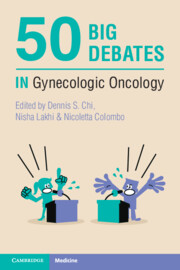Book contents
- 50 Big Debates in Gynecologic Oncology
- 50 Big Debates in Gynecologic Oncology
- Copyright page
- Contents
- Contributors
- Section I Perioperative Management
- Section II Screening, Prevention, and Early Diagnosis
- Debate 3A Should Women with BRCA Mutations be Offered Bilateral Salpingectomy with Delayed Oophorectomy for Ovarian Cancer Risk Reduction?
- Chapter 3B Should Women with BRCA Mutations be Offered Bilateral Salpingectomy with Delayed Oophorectomy for Ovarian Cancer Risk Reduction?
- Debate 4A Can High-risk HPV Testing be Used Alone as the Primary Screening Modality for Cervical Cancer?
- Debate 4B Can High-risk HPV Testing be Used Alone as the Primary Screening Modality for Cervical Cancer?
- Section III Ovarian Cancer
- Section IV Endometrial Cancer
- Section V Cervical Cancer
- Section VI Vaginal and Vulvar Cancer
- Index
- References
Debate 4B - Can High-risk HPV Testing be Used Alone as the Primary Screening Modality for Cervical Cancer?
No
from Section II - Screening, Prevention, and Early Diagnosis
Published online by Cambridge University Press: 20 July 2023
- 50 Big Debates in Gynecologic Oncology
- 50 Big Debates in Gynecologic Oncology
- Copyright page
- Contents
- Contributors
- Section I Perioperative Management
- Section II Screening, Prevention, and Early Diagnosis
- Debate 3A Should Women with BRCA Mutations be Offered Bilateral Salpingectomy with Delayed Oophorectomy for Ovarian Cancer Risk Reduction?
- Chapter 3B Should Women with BRCA Mutations be Offered Bilateral Salpingectomy with Delayed Oophorectomy for Ovarian Cancer Risk Reduction?
- Debate 4A Can High-risk HPV Testing be Used Alone as the Primary Screening Modality for Cervical Cancer?
- Debate 4B Can High-risk HPV Testing be Used Alone as the Primary Screening Modality for Cervical Cancer?
- Section III Ovarian Cancer
- Section IV Endometrial Cancer
- Section V Cervical Cancer
- Section VI Vaginal and Vulvar Cancer
- Index
- References
Summary
Cervical cancer, with a global incidence of 570,000 annually, causes 7.5% of all female cancer deaths. Screening has prevented about 80% of cases in developed countries. Evidence however continues to evolve on the best modality of screening. Primary screening with high-risk human papilloma virus (Hr-HPV) alone will lead to unnecessary interventions among women <30 years in whom Hr-HPV is very common but always transient. Based on this, the WHO, ACOG and United States Preventative Task Force do not recommend screening women <30 years with Hr-HPV. In addition, the American Society for Clinical Pathology advised that women undergoing Hr-HPV testing should have cytological examination at some point during their screening, as 9–10% of invasive cancers and 8.3–14% of high-grade squamous intraepithelial lesion (HSIL) are Hr-HPV negative, and Hr-HPV screening may cause delayed diagnosis and higher stage tumors. As countries transition to Hr-HPV-based screening, it is important to acknowledge the limitations and refine the utilization of the test.
- Type
- Chapter
- Information
- 50 Big Debates in Gynecologic Oncology , pp. 20 - 22Publisher: Cambridge University PressPrint publication year: 2023



